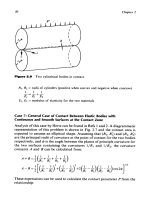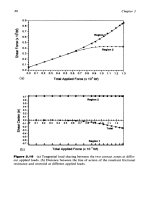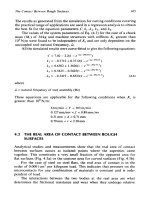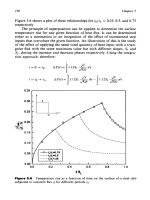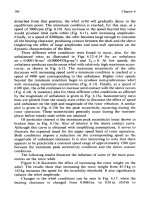Engineering - Materials Selection in Mechanical Design Part 1 pot
Bạn đang xem bản rút gọn của tài liệu. Xem và tải ngay bản đầy đủ của tài liệu tại đây (461.36 KB, 7 trang )
Introduction
1
.1
Introduction and synopsis
‘Design’ is one of those words that means all things to all people. Every manufactured thing, from
the most lyrical of ladies’ hats to the greasiest of gearboxes, qualifies, in some sense or other, as a
design. It can mean yet more. Nature, to some is Divine Design; to others it is design by Natural
Selection, the ultimate genetic algorithm. The reader will agree that it is necessary to narrow the
field, at least a little.
This book is about mechanical design, and the role of materials in it. Mechanical components
have mass; they carry loads; they conduct heat and electricity; they are exposed to wear and to
corrosive environments; they are made of one or more materials; they have shape; and they must
be manufactured (Figure 1.1). The book describes how these activities are related.
Materials have limited design since man first made clothes, built shelters and waged wars. They
still do. But materials and processes to shape them are developing faster now than at any previous
time in history; the challenges and opportunities they present are greater than ever before. The book
develops a strategy for exploiting materials in design.
1.2
Materials in design
Design is the process of translating a new idea or a market need into the detailed information from
which a product can be manufactured. Each of its stages requires decisions about the materials from
which the product
is
to be made and the process for making it. Normally, the choice of material is
dictated by the design. But sometimes it is the other way round: the new product, or the evolution
of the existing one, was suggested or made possible by the new material. The number of materials
available to the engineer is vast: something between
40
000
and
80
000
are at his or her (from here on
‘his’ means both) disposal. And although standardization strives to reduce the number, the continuing
appearance of new materials with novel, exploitable, properties expands the options further.
How, then, does the engineer choose, from this vast menu, the material best suited to his purpose?
Must he rely on experience? Or can a
systematic
procedure
be formulated for making a rational
choice? The question has to be answered at a number of levels, corresponding to the stage the
design has reached. At the beginning the design is fluid and the options are wide; all materials must
be considered.
As
the design becomes more focused and takes shape, the selection criteria sharpen
and the
shortlist
of materials which can satisfy them narrows. Then more accurate data are required
(although for a lesser number of materials) and a different way of analysing the choice must be
used. In the final stages of design, precise data are needed, but for still fewer materials
-
perhaps
only one. The procedure must recognize the initial richness of choice, narrow this to a small subset,
and provide the precision and detail on which final design calculations can be based.
2 Materials Selection in Mechanical Design
Fig. 1.1 Function, material, process and shape interact. Later chapters deal with each in turn.
The choice of material cannot be made independently of the choice of process by which the
material is to be formed, joined, finished, and otherwise treated. Cost enters, both in the choice
of material and in the way the material is processed. And -it must be recognized -good engi-
neering design alone is not enough to sell a product. In almost everything from home appliances
through automobiles to aircraft, the form, texture, feel, colour, decoration of the product- the
satisfaction it gives the person who buys or uses it -are important. This aesthetic aspect (known
confusingly as 'industrial design') is not treated in most courses on engineering, but it is one that,
if neglected, can lose the manufacturer his market. Good designs work; excellent designs also give
pleasure.
Design problems, almost always, are open-ended. They do not have a unique or 'correct' solution,
although some solutions will clearly be better than others. They differ from the analrtical problems
used in teaching mechanics, or structures, or thermodynamics, or even materials, which generally
do have single, correct answers. So the first tool a designer needs is an open mind: the willingness
to consider all possibilities. But a net cast widely draws in many fish. A procedure is necessary for
selecting the excellent from the merely good.
This book deals with the materials aspects of the design process. It develops a methodology
which, properly applied, gives guidance through the forest of complex choices the designer faces.
The ideas of material and process attributes are introduced. They are mapped on material and
process selection charts which show the lay of the land, so to speak, and simplify the initial
survey for potential candidate materials. The interaction between material and shape can be built
into the method, as can the more complex aspects of optimizing the balance between perfor-
mance and cost. None of this can be implemented without data for material properties and process
attributes: ways to find them are described. The role of aesthetics in engineering design is discussed.
The forces driving change in the materials world are surveyed. The Appendices contain useful
information.
Introduction
3
The methodology has further applications. It suggests
a
strategy for material development, partic-
ularly of composites and structured materials like sandwich panels. It points to
a
scheme for
identifying the most promising applications for new materials. And it lends itself readily to computer
implementation, offering the potential for interfaces with computer-aided design, function modelling,
optimization routines and
so
forth.
All this will be found in the following chapters, with case studies illustrating applications. But
first,
a
little history.
1.3
The evolution
of
engineering materials
Throughout history, materials have limited design. The ages in which man has lived are named for
the materials he used: stone, bronze, iron. And when he died, the materials he treasured were buried
with him: Tutankhamen with shards of coloured glass in his stone sarcophagus, Agamemnon with
his bronze sword and mask of gold, each representing the high technology of his day.
If they had lived and died today, what would they have taken with them? Their titanium watch,
perhaps; their carbon-fibre reinforced tennis racquet, their metal-matrix composite mountain bike,
their polyether-ethyl-ketone crash helmet. This is not the age of one material; it is the age of an
immense range of materials. There has never been an era in which the evolution of materials was
faster and the range of their properties more varied. The menu of materials available to the engineer
has expanded
so
rapidly that designers who left college twenty years ago can be forgiven for not
knowing that half of them exist. But not-to-know is, for the designer, to risk disaster. Innovative
design, often, means the imaginative exploitation of the properties offered by new or improved
materials. And for the man
in
the street, the schoolboy even, not-to-know is to miss one of the great
developments of our age: the age of advanced materials.
This evolution and its increasing pace are illustrated in Figure 1.2. The materials of pre-
history
(>
10
000
BC,
the Stone Age) were ceramics and glasses, natural polymers and composites.
Weapons
-
always the peak of technology
-
were made of wood and flint; buildings and bridges
of stone and wood. Naturally occurring gold and silver were available locally but played only
a
minor role in technology. The discovery of copper and bronze and then iron (the Bronze Age,
4000
BC-
1000
BC
and the Iron Age,
1000
BC-AD
1620) stimulated enormous advances, replacing
the older wooden and stone weapons and tools (there is
a
cartoon on my office door, put there by
a
student, presenting an aggrieved Celt confronting
a
swordsmith with the words ‘You sold me this
bronze sword last week and now I’m supposed to upgrade to iron!’). Cast iron technology (1620s)
established the dominance of metals in engineering; and the evolution of steels
(1850
onward), light
alloys (1940s) and special alloys since then consolidated their position. By the 1960s, ‘engineering
materials’ meant ‘metals’. Engineers were given courses in metallurgy; other materials were barely
mentioned.
There had, of course, been developments in the other classes
of’
material. Portland cement, refrac-
tories, fused silica among ceramics, and rubber, bakelite, and polyethylene among polymers, but
their share of the total materials market was small. Since 1960 all that has changed. The rate of
development of new metallic alloys is now slow; demand for steel and cast iron has in some coun-
tries actually fallen’. The polymer and composite industries, on the other hand, are growing rapidly,
and projections
of
the growth of production of the new high-performance ceramics suggests rapid
expansion here
also.
*
Do
not, however, imagine that the days
of
steel
are
over. Steel production accounts
for
90%
of
all world metal output,
and its unique combination
of
strength, ductility. toughness and low price makes steel irreplaceable.
4
Materials Selection in Mechanical Design
Fig.
1.2
The evolution
of
engineering materials with time. ‘Relative Importance’ in the stone and bronze
ages is based on assessments of archaeologists: that in
1960
is based on allocated teaching hours in
UK
and
US
universities; that in
2020
on predictions of material usage in automobiles by manufacturers.
The time scale is non-linear. The rate of change is far faster today than at any previous time in history.
This rapid rate of change offers opportunities which the designer cannot afford to ignore. The
following case study is an example. There are more in Chapter
15.
1.4
The evolution
of
materials in vacuum cleaners
‘Sweeping and dusting are homicidal practices: they consist
of
taking dust from the floor, mixing
it
in the atmosphere, and causing it to be inhaled by the inhabitants of the house. In reality it
would be preferable to leave the dust alone where it was.’
That was a doctor, writing about 100 years ago. More than any previous generation, the Victorians
and their contemporaries in other countries worried about dust. They were convinced that it carried
disease and that dusting merely dispersed it where, as the doctor said, it became yet more infectious.
Little wonder, then, that they invented the vacuum cleaner.
The vacuum cleaners of 1900 and before were human-powered (Figure 1.3(a)). The housemaid,
standing firmly on the flat base, pumped the handle of the cleaner, compressing bellows which,
with leather flap-valves to give a one-way flow, sucked air through a metal can containing the filter
at a flow rate of about
1
litre per second. The butler manipulated the hose. The materials are, by
today’s standards, primitive: the cleaner is made almost entirely from natural polymers and fibres;
wood, canvas, leather and rubber. The only metal is the straps which link the bellows (soft iron)
and the can containing the filter (mild steel sheet, rolled to make a cylinder). It reflects the use
of
materials in
1900.
Even a car, in 1900, was mostly made of wood, leather, and rubber; only the
engine and drive train had to be metal.
Introduction 5
The electric vacuum cleaner first appeared around 1908*. By 1950 the design had evolved into
the cylinder cleaner shown in Figure 1.3(b) (flow rate about 10 litres per second). Air flow is axial,
drawn through the cylinder by an electric fan. The fan occupies about half the length of the cylinder;
the rest holds the filter. One advance in design is, of course, the electrically driven air pump. The
motor, it is true, is bulky and of low power, but it can function continuously without tea breaks or
housemaid's elbow. But there are others: this cleaner is almost entirely made of metal: the case, the
endcaps, the runners, even the tube to suck up the dust are mild steel: metals have replaced natural
materials entirely.
Developments since then have been rapid, driven by the innovative use of new materials. The
1985 vacuum cleaner of Figure 1.3(c) has the power of roughly 18 housemaids working flat out
.Inventors: Murray Spengler and William B. Hoover. The second name has become part of the English language, along
with those of such luminaries as John B. Stetson (the hat), S.F.B. Morse (the code), Leo Henrik Baikeland (Bakelite) and
Thomas Crapper (the flush toilet).
Introduction
5
(a)
1905
(b)
1950
(c)
1985
(d)
1997
Fig.
1.3
Vacuum cleaners: (a) The hand-powered bellows cleaner of 1900, largely made
of
wood and
leather.
(b)
The cylinder cleaner of 1950. (c) The lightweight cleaner
of
1985, almost entirely polymer.
(d)
A
centrifugal dust-extraction cleaner of 1997.
6
Materials Selection in Mechanical Design
Table
1.1
Comparison
of
cost, power and weight
of
vacuum
cleaners
Cleaner trnd Dute Dominant materials Power Weight
Cost*
(W)
(kg)
Hand powered,
1900
Wood,
canvas,
leather
50
10
&240/$380
Cylinder,
1950
Mild Steel
300
6
&96/$150
Cylinder,
1985
Moulded
ABS
and
800
4
f60/$95
Dyson,
1995
Polypropylene,
1200
6.3
&190/$300
polypropylene
polycarbonate,
ABS
*Costs have been adjusted
to
1998
values, allowing
for
inflation.
(800
watts) and a corresponding air flow rate; cleaners with twice that power are now available. Air
flow is still axial and dust removal by filtration, but the unit is smaller than the old cylinder cleaners.
This is made possible by a higher power-density in the motor, reflecting better magnetic materials
and higher operating temperatures (heat-resistant insulation, windings and bearings). The casing
is entirely polymeric, and is an example of good design with plastics. The upper part is a single
moulding, with all additional bits attached by snap fasteners moulded into the original component.
No
metal is visible anywhere; even the straight part of the suction tube, metal in all earlier models,
is now polypropylene. The number of components is enormously reduced: the casing has just four
parts, held together by just one fastener, compared with
11
parts and
28
fasteners for the 1950
cleaner. The saving on weight and cost
is enormous, as the comparison in Table
1.1
shows.
It
is
arguable that this design (and its many variants) is near-optimal for today’s needs; that a
change of working principle, material or process could increase performance but at
a
cost penalty
unacceptable to the consumer. We will leave the discussion of balancing performance against cost
to
a later chapter, and merely note here that
one
manufacturer disagrees. The cleaner shown in
Figure 1.3(d) exploits a different concept: that of centrifugal separation, rather than filtration. For
this
to
work, the power and rotation speed have to be high; the product is larger, noisier, heavier
and much more expensive than the competition. Yet it sells
-
a
testament to good industrial design
and imaginative, aggressive marketing.
All this has happened within one lifetime. Competitive design requires the innovative use of
new materials and the clever exploitation of their special properties, both engineering and aesthetic.
There have been many manufacturers of vacuum cleaners who failed to innovate and exploit; now
they are extinct. That sombre thought prepares us for the chapters which follow, in which we
consider what they forgot: the optimum use of materials in design.
1.5
Summary and conclusions
The number
of
engineering materials is large: estimates range from
40
000
to
80
000.
The designer
must select from this vast menu the material best suited to his task. This, without guidance, can be a
difficult and tedious business,
so
there is a temptation to choose the material that is ‘traditional’ for
the application: glass for bottles; steel cans. That choice may be safely conservative, but it rejects
the opportunity for innovation. Engineering materials are evolving faster, and the choice is wider
than ever before. Examples of products in which a novel choice of material has captured
a
market
are as common as
-
well
-
as plastic bottles. Or aluminium cans.
It
is important in the early
stage of design, or
of
re-design, to examine the full materials menu, not rejecting options merely
because they are unfamiliar. And that is what this book
is
about.
Introduction
7
1.6
Further reading
The history and evolution of materials
Connoisseurs will tell you that
in
its 11th edition the
Encyclopaedia Britannica
reached a peak
of
excellence which has not since been equalled, although subsequent editions are still usable. On
matters
of
general and technical history it, and the seven-volume
History
of
Technology,
are the
logical starting points. More specialized books on the history and evolution
of
metals, ceramics,
glass, and plastics make fascinating browsing.
A
selection
of
the most entertaining is given below.
‘Encyclopaedia Brirannica’,
1 1 th edition. The Encyclopaedia Britannica Company, New
York
1910.
Davey,
N.
(1960)
A
History
of
Building Materials.
Camelot Press, London,
UK.
Delmonte,
J.
(1985)
Origins
of
Materials and Processes.
Technomic Publishing Company, Pennsylvania.
Derry, T.K. and Williams,
T.I.
(1960)
A
Short History
of
Technology’.
Oxford University Press, Oxford.
Dowson,
D.
(1979)
History
of
Tribology’.
Longman, London.
Michaelis, R.R. (1992) Gold: art, science and technology,
Interdisciplinary Science Reviews,
17(3), 193.
Singer, C., Holmyard,
E.J.,
Hall,
A.R.
and Williams, T.I. (eds) (1954-1978)
A
History
qf
Technology
(7
Tylecoate, R.F. (1992)
A
History of Metallurgy,
2nd edition. The Institute
of
Materials, London.
volumes plus annual supplements). Oxford University Press, Oxford.
Vacuum cleaners
Forty,
A.
(1
986)
Objects ofDesire: Design and Society since
1750,
Thames and Hudson, London, p. 174 et seq.


